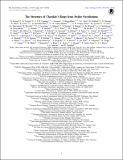The Structure of Chariklo’s Rings from Stellar Occultations
Author(s)
Gulbis, Amanda A. S.
DownloadBérard_2017_AJ_154_144.pdf (2.305Mb)
PUBLISHER_POLICY
Publisher Policy
Article is made available in accordance with the publisher's policy and may be subject to US copyright law. Please refer to the publisher's site for terms of use.
Terms of use
Metadata
Show full item recordAbstract
Two narrow and dense rings (called C1R and C2R) were discovered around the Centaur object (10199) Chariklod uring a stellar occultation observed on 2013 June 3. Following this discovery, we planned observations of several occultations by Chariklos system in order to better characterize the physical properties of the ring and main body. Here, we use 12 successful occulations by Chariklo observed between 2014 and 2016. They provide ring profiles (physical width, opacity, edge structure) and constraints on the radii and pole position. Our new observations are currently consistent with the circular ring solution and pole position, to within the ±3.3 km formal uncertainty for the ring radii derived by Braga-Ribas et al. The six resolved C1R profiles reveal significant width variations from ∼5 to 7.5 km. The width of the fainter ring C2R is less constrained, and may vary between 0.1 and 1 km. The inner and outer edges of C1R are consistent with infinitely sharp boundaries, with typical upper limits of one kilometer for the transition zone between the ring and empty space. No constraint on the sharpness of C2Rs edges is available. A 1σ upper limit of ∼20 m is derived for the equivalent width of narrow (physical width < 4 km) rings up to distances of 12,000 km, counted in the ring plane.
Date issued
2017-09Department
Massachusetts Institute of Technology. Department of Earth, Atmospheric, and Planetary SciencesJournal
Astronomical Journal
Publisher
IOP Publishing
Citation
Bérard, D. et al. “The Structure of Chariklo’s Rings from Stellar Occultations.” The Astronomical Journal 154, 4 (September 2017): 144 © 2017 The American Astronomical Society
Version: Final published version
ISSN
1538-3881
0004-6256